Coyote populations on Antelope Island have declined dramatically over the last few years and recent disturbing events had some of us wondering if Utah State Parks was practicing predator control on the island. Yesterday afternoon I was on a mission to find out.
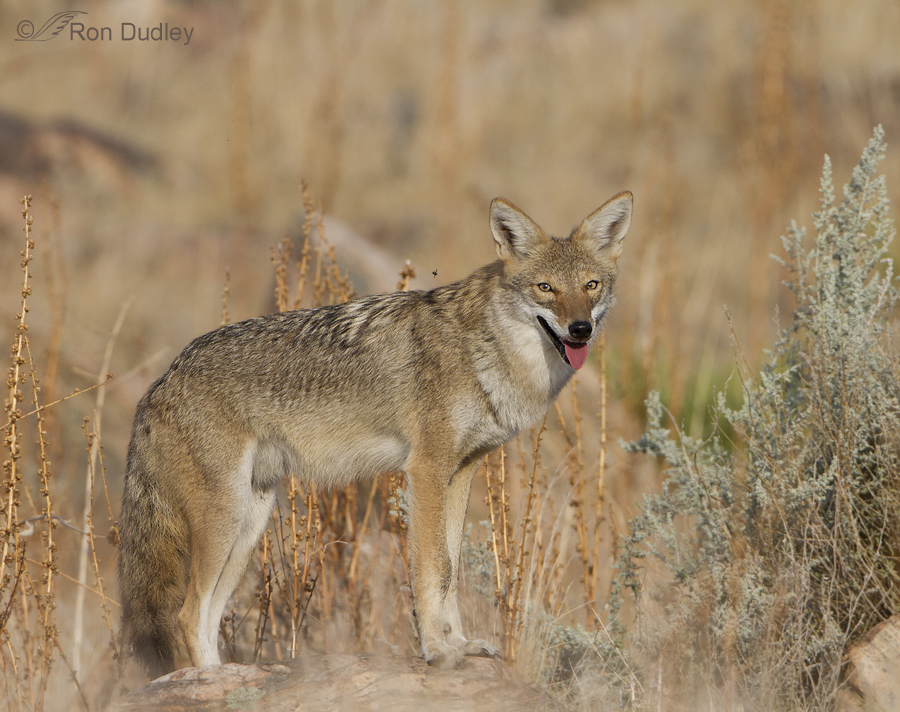
As a bird and wildlife photographer I’ve been visiting Antelope Island 2-3 times per week for over 10 years now and I pay very close attention to the flora and fauna I encounter. Until a few years ago coyotes on the island were almost ubiquitous. It was rare to not see at least a few coyotes on each visit and sometimes I’d see over a dozen, like this handsome fellow seeming to smile for the camera.
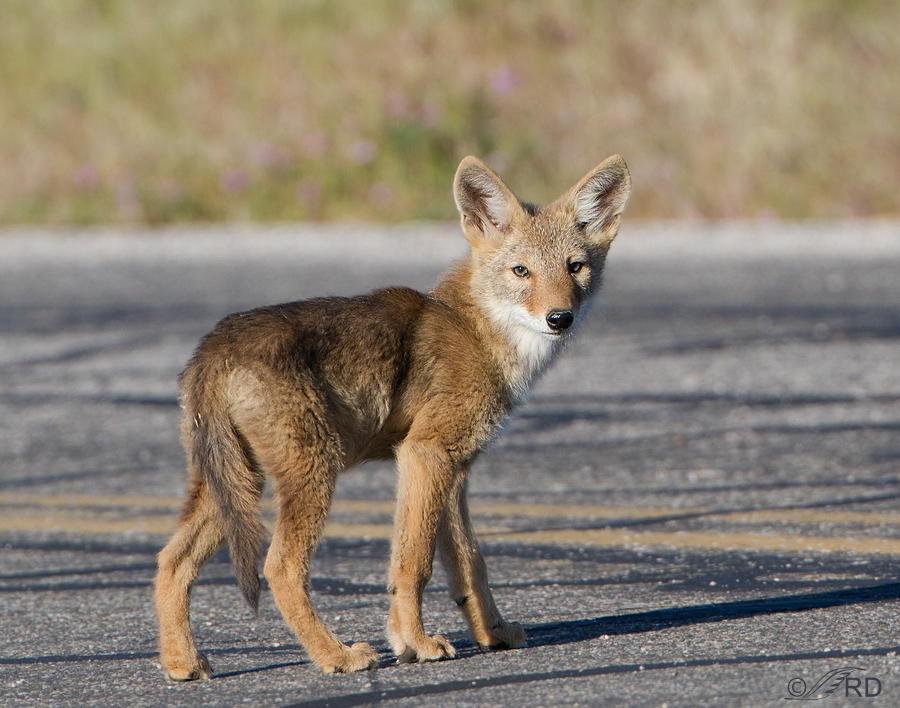
I was aware of the locations of several dens, including one near Buffalo Point that produced this cute little guy. Who wouldn’t love that face and those long, gangly legs?
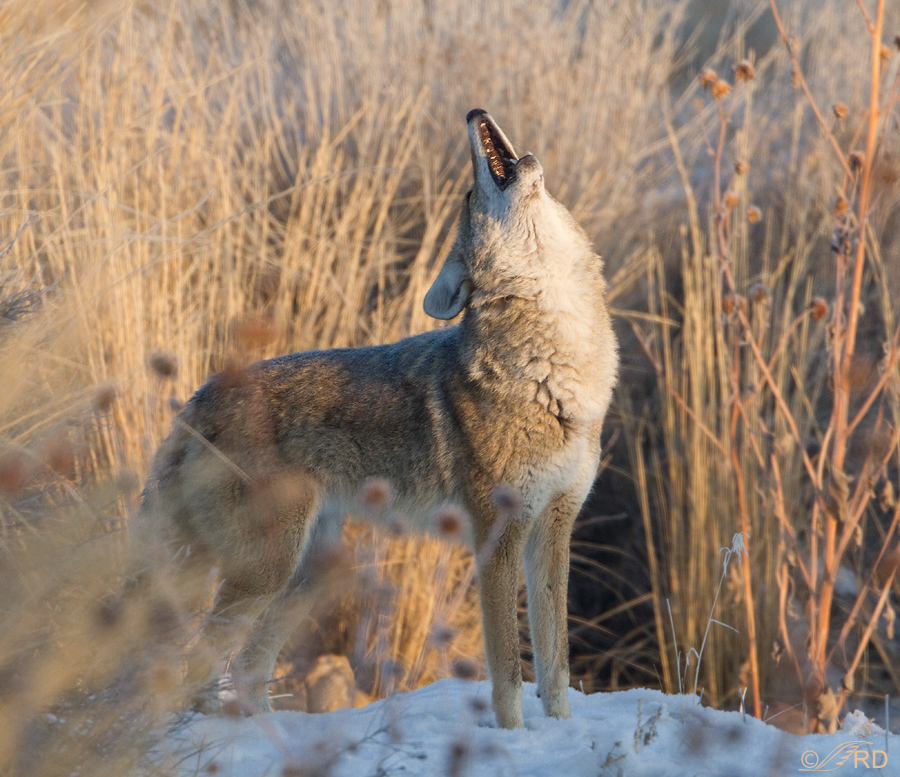
My visits to the island are always at or near dawn so the sounds of howling coyotes echoing off the hills were a significant and welcome part of my world. This one even gave me a personal and up-close demonstration, a loud and almost haunting performance.
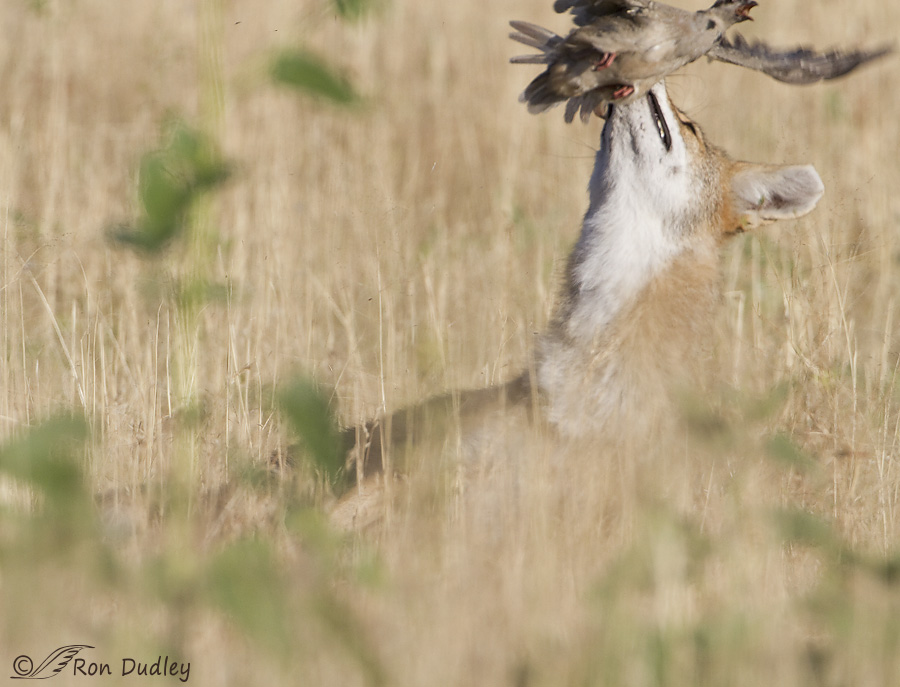
Coyotes on the island were common enough that over time I was able to document many aspects of their lives including their pair bonds, family relationships, reproduction, foraging techniques and hunting strategies. I watched this younger coyote as it stalked juvenile chukars in the grass and then nearly caught one of them when it flushed beneath his feet. In this instance all the coyote succeeded in capturing was a couple of tail feathers but he came very close to enjoying a meal of young chukar. That was one lucky bird!
Coyotes are perhaps the classic example of opportunistic feeders – they’ll eat just about anything they can catch and they’re also scavengers but in my experience with them on the island voles are the most important component of their diet. I’ve documented coyotes hunting/eating ducks, grebes, pheasants, eggs, rabbits, and carcasses of deer, pronghorn and bison and they often scavenge Peregrine and Prairie Falcon kills along the causeway to the island.
But based on my observations the vast majority of their prey/food items on the island is voles.
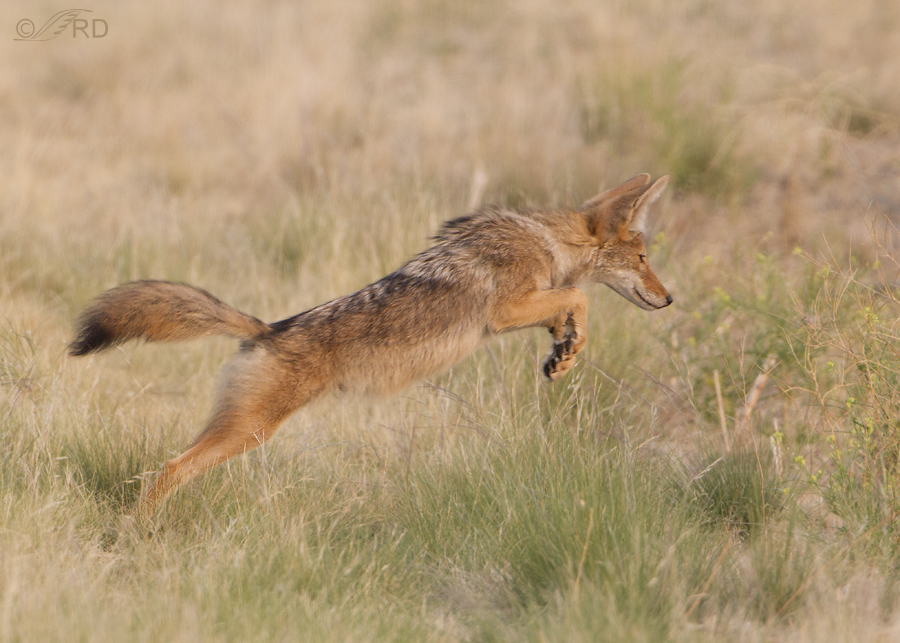
They’re highly skilled at hunting those little rodents and they do it…
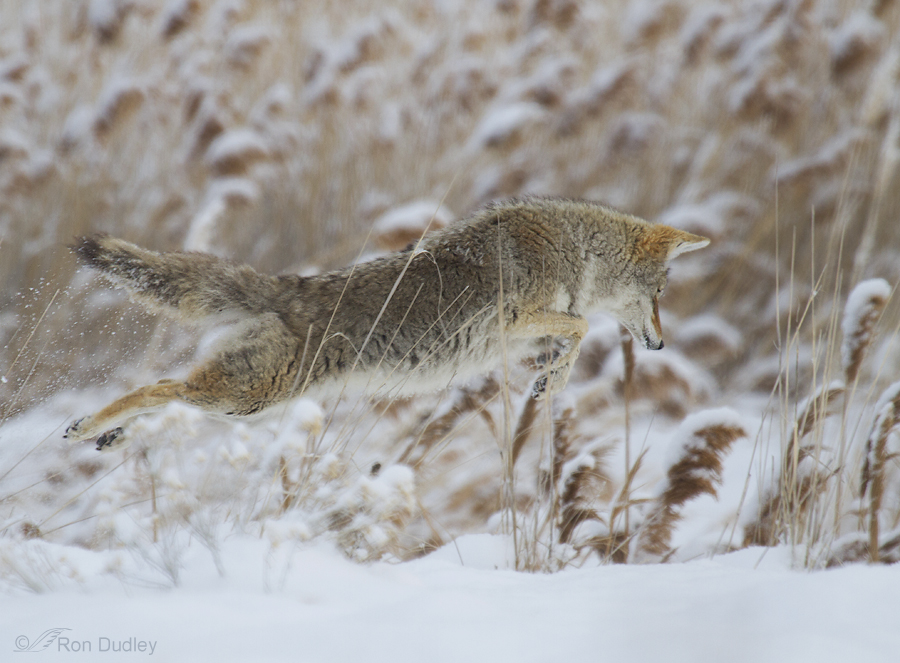
no matter the season.
But that’s how it used to be. In recent years it’s unusual, even rare, to see a coyote on the island and I’ve often wondered why. Eventually I became suspicious that managers on the island might be practicing coyote control so over a period of roughly three years I asked three different park rangers if that was the case. Their answer was always an emphatic and unequivocal “no” and I accepted that response as fact. Until yesterday.
In yesterday’s blog post about low-flying aircraft I documented a yellow Piper Cub that I’d twice photographed flying low and slow over the island. That plane turned out to be registered to USDA-APHIS-WS, an agency of the federal government. My first assumption was that it was on some legitimate business on the island, perhaps doing wildlife or plant surveys
It didn’t even occur to me that it might be associated with the notorious “Wildlife Services” arm of the USDA until blog reader Mike Fortin posed this link in the comments. Included in the link is this statement describing the activities of Wildlife Services:
- “In the Western Region, aerial missions are flown almost exclusively to protect valuable livestock (sheep, cattle, and goats) from predators. These missions use single-engine Super Cub or Top Cub aircraft flown at low altitude, and at relatively slow speeds”
I was immediately alarmed and so were many of my readers. Was it possible that state park managers had been less than honest with me and had been surreptitiously complicit in killing coyotes in the state park all along? What else could explain both the mysterious decline of coyote populations and the presence of Wildlife Services (damn, I hate that deliberately misleading name!) planes flying low and slow over the island?
So yesterday I was on a mission! I visited the island in the afternoon (something I never do that time of day) and sought out Jeremy Shaw, manager of Antelope Island State Park. I spent roughly 40 minutes with Jeremy and asked him many pointed questions. Here’s what I found out:
- No, island managers do not practice coyote control on the island. Jeremy and his staff are dedicated to protecting all the wildlife and natural habitats on the island with no exceptions.
- Jeremy has no explanation for the presence of “Wildlife Services” in the airspace of the island other than the possibility that the planes fly out of one of the Salt Lake airports and pass over the island on the way to do their dirty work up north and the pilots can’t resist flying low and slow over the island “just because they can”.
Of course Jeremy and park staff are very aware of the decline in coyote numbers in recent years but they have no conclusive answer as to why.
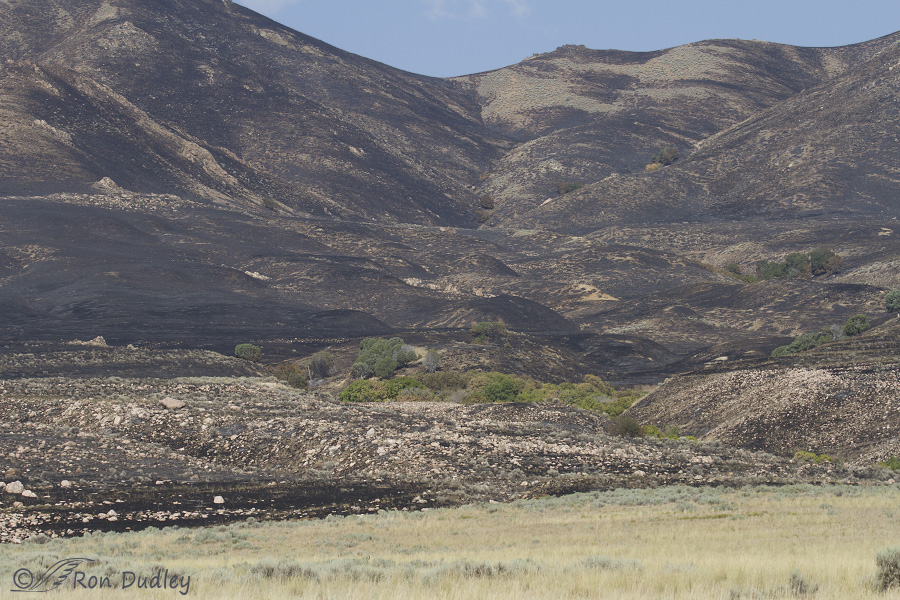
However, Jeremy suspects that it may be largely due to the July 2016 wildfire that consumed almost half of the 28,000 acre island. Much of the critical habitat for wildlife on the island was destroyed, including habitat for many of the species that coyotes hunt and scavenge.
We also discussed the possibility that other factors may be involved, including the cyclic nature of vole populations that seem to have declined seriously about the same time that coyote numbers began to drop. Jeremy said that vole studies may be on the near horizon in an attempt to find out more about what may be going on. When it comes to managing natural resources there are often no easy answers and this is just another example of that unfortunate fact.
Every time I visit with Jeremy I’m more impressed by his dedication, professionalism and personal qualities. He was accessible, forthcoming and obviously passionate about wisely managing the resources of the island for the benefit of visitors and the natural systems he’s charged to protect.
In my view Jeremy Shaw is one of the most valuable assets of the Utah State Parks system.
Ron


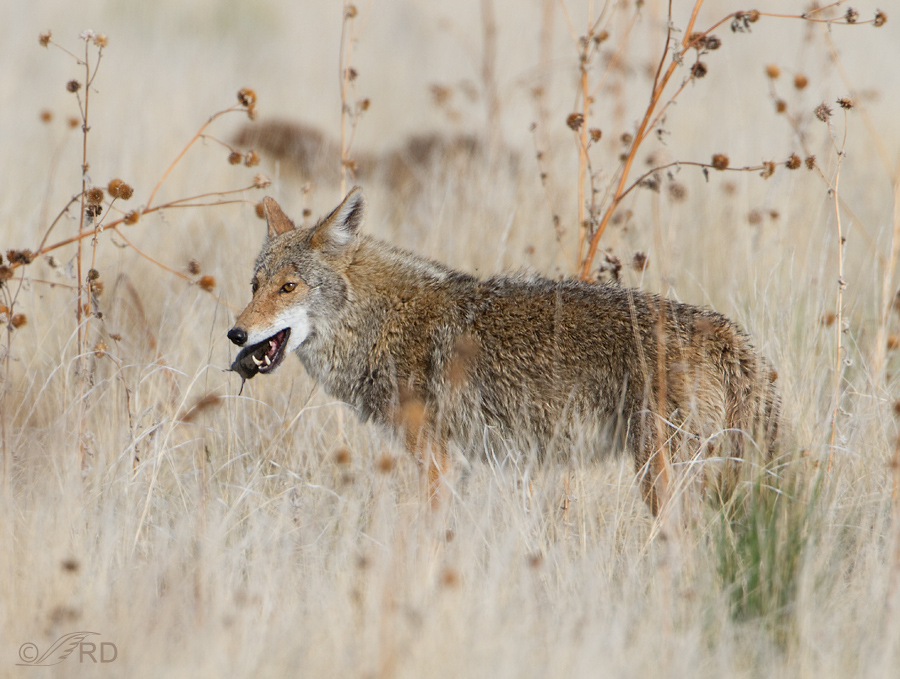
Here’s to the howling success of the return of the coyote!
Hear, hear!
Thanks for being a ‘watch dog’ Ron, digging deeper and getting answers. I’m rooting for the wildlife and will continue my visits to the island. Love your posts and appreciate your commitment.
I’m glad you’re not giving up on the island, Sandy. I think they deserve our support out there.
This is a very nice series on the coyotes Ron and I’m glad your park is in good hands with Jeremy.
Coyotes doing well out here in Sonoma County and the surrounding areas as well. Recently saw one young buck in his pickup truck sporting a sticker that said “Pack A Day Club” with a coyote image. Some of the ranchers out here go after them, but not all of them do so.
Hope your regeneration and regrowth is coming along after the big fire in ’16.
Thanks, Dave. Some of the regrowth after the fire is doing well but much of it, sagebrush for example, takes a very long time to recover.
Great post with beautiful photos! You sure had me on the edge of my seat. I’m glad the Ranger turned out to be one of the “good guys” !
Thanks, Joanne. Wish we had more folks like Jeremy making decisions about our natural resources.
Thank you so much Ron for giving a damn and working on behalf of our wild critters ! In my state you can kill coyotes with impunity and I hate it , I also hate seeing their heads on fence posts ! There is also a “season” for killing bobcats !
I can understand it to some extent if you are willing to eat the meat of an animal you kill but coyote and bobcats are not dinner fare .
I just don’t understand !
You can kill them with impunity here too, Laurel – except in certain very limited areas like Antelope Island. Jeremy told me that not a week goes by that they don’t get inquiries from folks wanting to come onto the island to kill them.
After reading your title, I was afraid that today’s post would leave me as furious as yesterday’s (my comments would have been NC-17 and then-some, so that’s why I didn’t).
Fortunately, thanks to your wonderful coyote shots and answers from Jeremy Shaw, I’m only seething a little bit.
I haven’t seen our neighborhood coyotes lately, but then I also haven’t been out among-em before 6 am lately either.
I remember seeing and hearing lots of suburban coyotes when I lived in CA, Marty. I always enjoyed having them around.
Thank you so much for this follow up.
And please, pretty please can we clone Jeremy. The world needs a LOT more people like him.
Loved the coyote shots. So very much.
Ha, your cloning comment made me smile, EC. I’ll bet Jeremy would enjoy it too.
Nice series of the “singing dog”…sad commentary…
Thank you, Patty.
Excellent post today with excellent photos as usual. I especially love the winter pounce! Made me really smile! This information goes to show how interruption in one cog in the circle of life has it’s effect on the next and so on it goes. I find it easier to accept if it nature induced rather than man in his un-wisdom trying to change that circle. I have found too many of the smart ideas were never really thought out for consequences they deliver down the road.
Yup, they call it the “web of life” and a “food chain” for good reason, Kathy. Everything’s interconnected in ways far too complex for us to fully understand.
Good job following up on this, Ron. Your response in general seems wise. Wish we could get rid of Wildlife Services. I first testified against their practices with an Audubon group in Meeker, CO, the heart of sheep country in Colorado, about 50 years ago. The specific topic than was 1080, which was eventually banned. Unfortunately Wildlife Services continue to do their overall dastardly deeds. Recently Colorado Parks and Wildlife hired Wildlife Services to kill mountain lions and bears for a wide-ranging “research” project to see if they could shore up the declining mule deer population in an area with majo oil and gas impact. Despite thousands of complaints from citizens, who pointed out the research showing that this is not a productive approach, CPW went forward with the project. Perhaps in the next period of idealistic wildlife conservation we will succeed at getting rid of Wildlife Services.
I’d absolutely love to get rid of WS, Nancy.
I think my friend Ed MacKerrow hit the nail squarely on the head when he said this in his comment below:
“those guys/gals with WS are psychopaths, love to kill, love to play with their guns. They should have played more games of toy soldiers when they were kids”
Perhaps Jeremy Shaw could contact one of the higher ups at USDA-APHIS-WS and request that their pilots maintain at least 500′ altitude when flying over Antelope Island. Coming from him, I would think it might carry some weight. I would hope that government agencies would cooperate with each other, particularly with such a simple and reasonable request.
If the coyote and vole population decline is due to the fire, I imagine it’s only a matter of time before they are restored. I certainly hope so. I love your coyote photographs!
Thanks, David. I have confidence in how Jeremy will handle the situation with Wildlife Services so I don’t think I’ll be suggesting anything. He’s the professional and he knows all the implications (political and otherwise) better than I do.
And I dearly hope that you’re right about it being “only a matter of time”.
Several years ago in west Marin and Sonoma, CA, we had a decline in the vole population, and there was a subsequent drop in the Coyote population and other predators eating voles as their main food source. As the cycle reversed the Coyotes came back, and so did everyone else. Interesting to follow all of natures cycles.
Lydia, Jeremy actually lives on the island and he said that he’s beginning to hear them howling more often now. I hope that’s a sign that both coyotes and voles are finally bouncing back.
Thank you for following up; I’ve only seen a coyote once, in the vineyards, at night, however I think they are fascinating and wonderful creatures. And an important part of the ecosystem. Thank you for your dedication to the wildlife!
Thanks, Nicky. And I’ll bet you won’t soon forget your single experience with a coyote. In my view they’re very special critters.
Another fantastic post, Ron! The quality of information/education you provide with your photos every morning is much appreciated. Thanks again for a great start to the day.
Thank you, Diane. I don’t put this much time and effort into all of my posts but this situation put a burr up my butt so I had to investigate. And report.
G-Day Ron, Thanks for the Coyote photos; especially the jump, pounce, and did you see a happy tail wag if they detected a paw capture? The interviewed thoughts on their populations decline at the Antelope Island Refuge, is similar to a discussion I had with park rangers at “Florissant Fossil Beds National Monument” (Rt24) just West of Colorado Springs, CO.; we visited to view the Petrified Redwood Stumps that this Nat. Park is primarily noted for, on our way to Gunnison, Colorado for a past years Sage Grouse Conference. While amazed at the size and the numbers of remaining “Stumps” of petrified preserved Redwoods I couldn’t help but notice quite a few scat droppings along side the many trails (they were respectful for human foot traffic for their deposits) that I judged as Coyote. After examining some scat it seemed evident their main diet was Voles as the dark charcoal short fur is unmistakable and abundant in all scat I observed and was acknowledged as a primary food for Coyotes by staff. Getting back to the “tail wag”, is what we’ve observed as a happy response after the successful pounce here in NE Ohio, and I believe you’ve noted in the past, they do gulp them done whole.
You bet, I’ve seen that tail wag a fair number of times, Donald. It always makes me smile.
I’ve rarely examined coyote scat but what you describe is exactly what I see most often in the pellets cast by Red-tailed Hawks, Rough-legged Hawks, Swainson’s Hawks, Short-eared Owls and often Burrowing Owls.
https://www.featheredphotography.com/blog/2017/01/13/swainsons-hawk-regurgitating-pellets-then-i-dissected-them/
Excellent sleuthing, Ron!
Very much appreciate the update.
Thanks a lot, Art. I just had to find out…
Excellent coyote photos Ron. That little guy is adorable. I have always loved coyotes, but I guess if I was a rancher or farmer I might look at them differently. I applaud your efforts to learn more about the declining coyote populations as well as looking into the overflights. Thanks for sharing.
Everett Sanborn, Prescott AZ
PS: Here, our coyotes hunt our gophers in the exact same way they hunt your voles
Thanks, Everett. Studies show that coyote control is ineffective in significantly reducing predator predation on livestock and thankfully at least a few ranchers are finally beginning to realize that. I hope the trend continues and accelerates.
Very interesting to see you digging deep into the issue. Our Marsh Rabbits started declining in number about 8 years ago. At first I thought this was a cyclical phenomenon, the predator-prey relationship. We do have Bobcats which are efficient predators. However the rabbits still have not rebounded. In some areas of the Everglades the introduced pythons are blamed for similar extended reductions in small mammal populations, but so far I have not found any pythons in our local wetland preserve. I believe it may be related to the overgrowth of exotic trees and shrubs, notably Australian Pines, Melaleucas and Brazilian Pepper, which has transformed the ecosystem from a wet prairie to mostly dense woodland. This has been due to willful neglect by the agency which is responsible for oversight of the conservation easements which were granted to developers who set the land aside to compensate for destruction of the historic Everglades.
“This has been due to willful neglect by the agency which is responsible for oversight”
Those are highly disturbing words, Ken. “Development” having priority over wise management seems to be the rule rather than the exception these days, especially given our current political climate.
Great article, Ron, and your coyote photographs are some of the best I have seen! I hope the Wildlife Services yellow plane was not shooting…I have my doubts…
Thanks, Ed. I’ve never once heard gunshots on the island but then I avoid the place during the limited hunts that are allowed. But I know from experience that those “Wildlife Services” guys are sneaky as hell so it’s possible they’re shooting on the back side of the island – if so I likely would never hear it.
Ron, yes, those guys/gals with WS are psychopaths, love to kill, love to play with their guns. They should have played more games of toy soldiers when they kids
Your story and photos are excellent. You may be interested in getting in touch with Project Coyote. What I like about your article is that you have a long term persistent monitoring of the coyote population, with excellent photos, and you have noticed a decline in population. Many, if not all, of the pro-coyote killing groups try to convey a frame that coyote populations are always growing, all the time, everywhere… not the case on Antelope Island…
It’s FAR from the case on Antelope Island, Ed. And I wholeheartedly agree with your assessment of WS agents. I talked to one of them for a few minutes several years ago – a nasty experience to be sure.
I’m somewhat familiar with Project Coyote but haven’t checked up on their activities for a while. I’ll try to again…
Beautiful series & write up. Although I’m primarily a birder, I love anything with nature & wildlife, specially LIFE. Thanks for this post.
Thank you, Elmer.
Interesting! Glad you pursued it…… The destruction from the fire makes sense to me as well as the cyclic nature of the voles. I know Voles are cyclic here tho never disappearing completely. Perhaps the “old biology teacher” can make a point of observing such things tho I’m guessing Vole counting is a bit of a challenge! Coyote populations fluctuate here also and not just to do with hunters…………
The destruction from the fire makes sense to me as well as the cyclic nature of the voles. I know Voles are cyclic here tho never disappearing completely. Perhaps the “old biology teacher” can make a point of observing such things tho I’m guessing Vole counting is a bit of a challenge! Coyote populations fluctuate here also and not just to do with hunters…………
Judy, it used to be that when I was photographing birds on the island I’d often see voles scurrying about on the ground. Haven’t seen one on the island for years now and there’s been a corresponding decline in critters that feed on them, including coyotes, Red-tailed Hawks and Rough-legged Hawks in winter.
My observations aren’t proof of anything but it seems to me to be more than just coincidence.
Long term observations don’t count as scientific “proof” of course, BUT they are sure valuable in the world I live in!